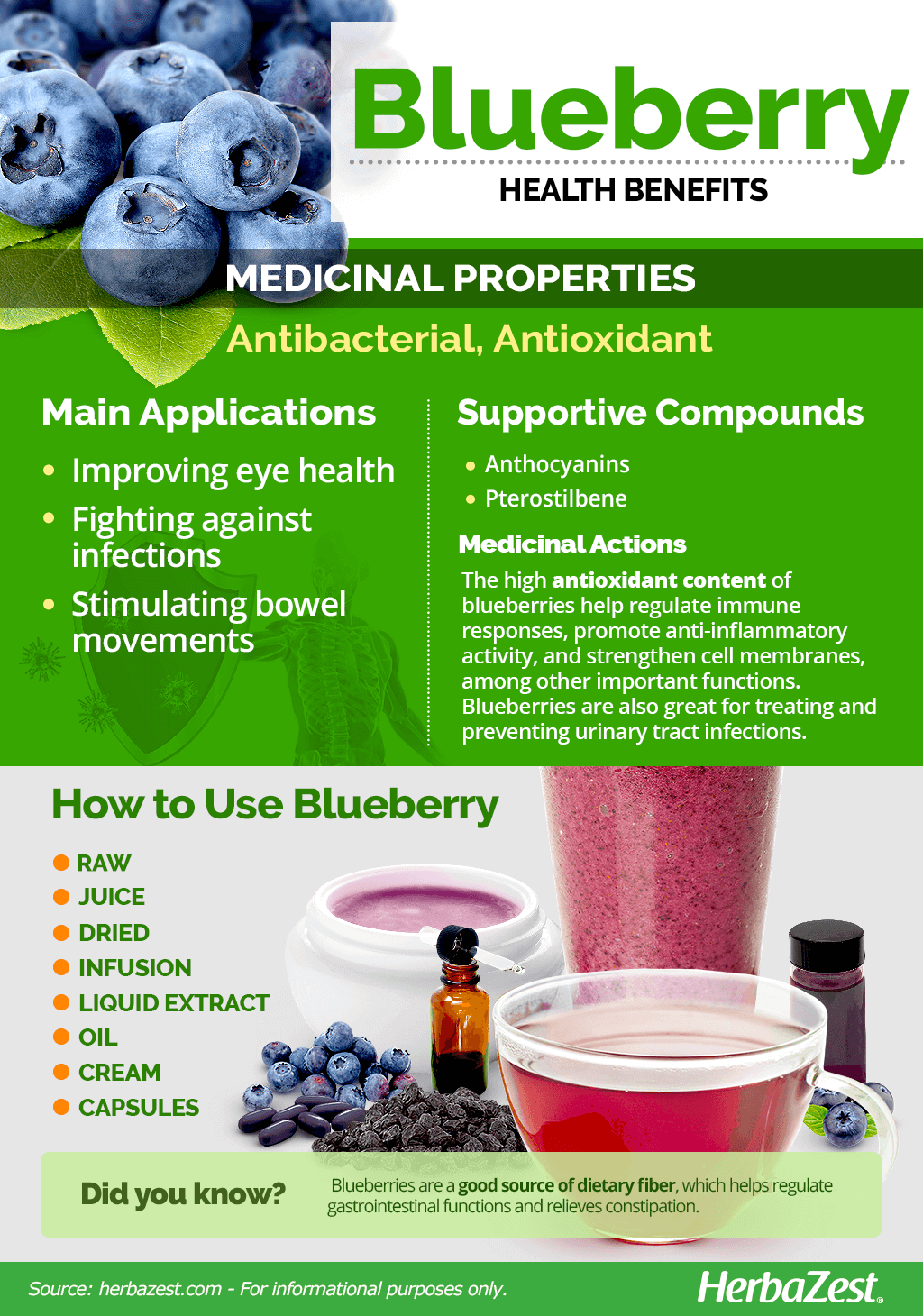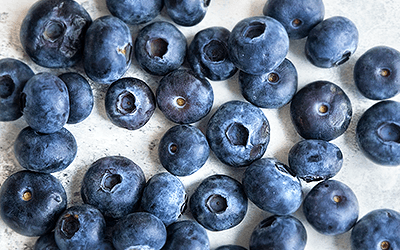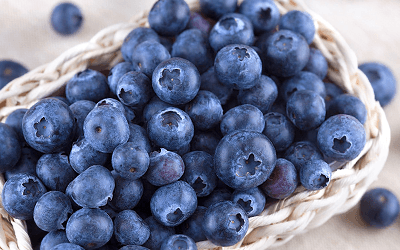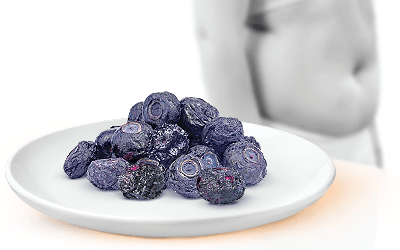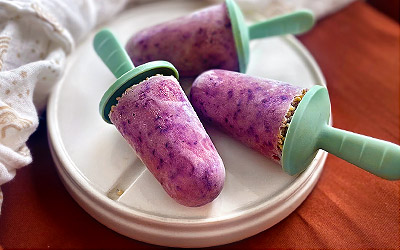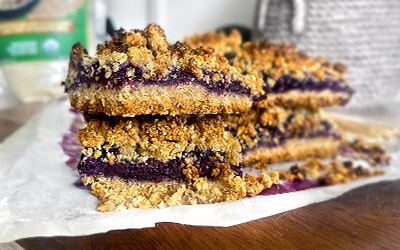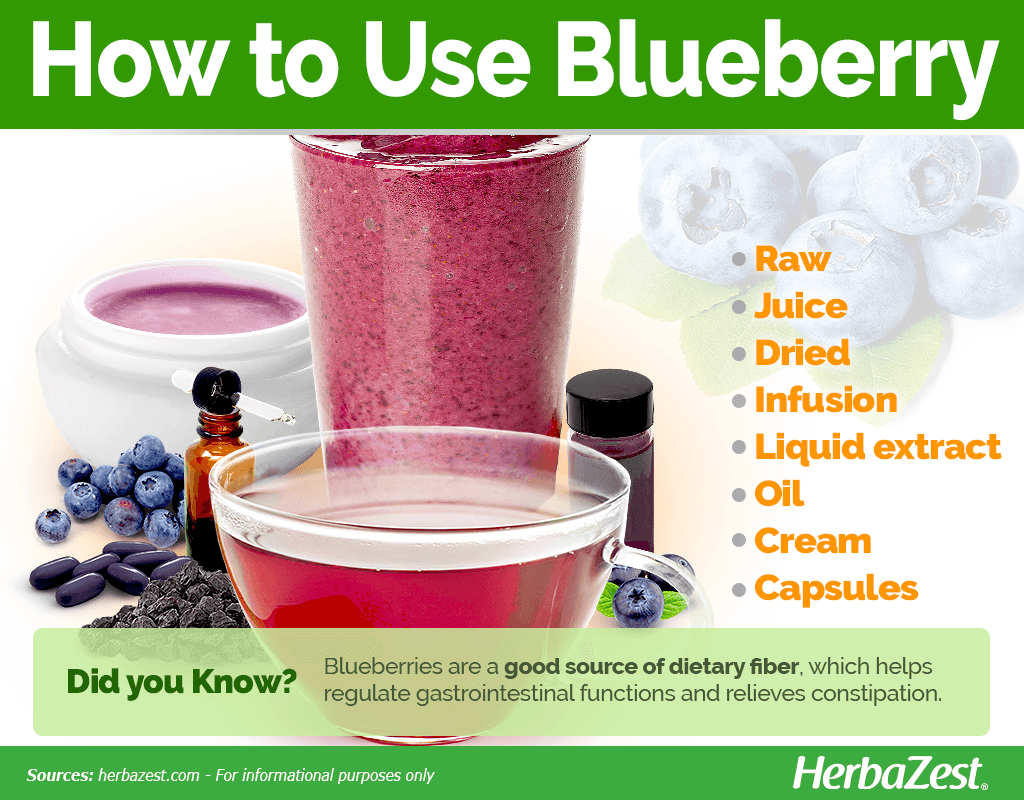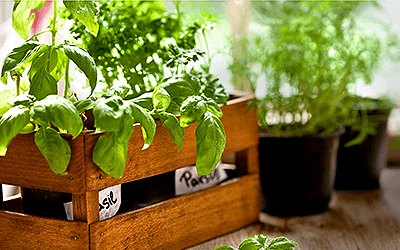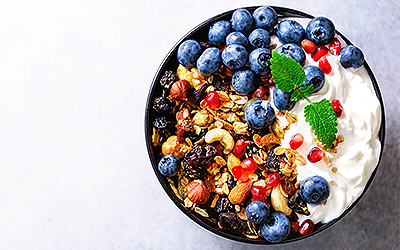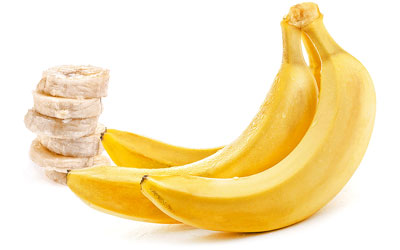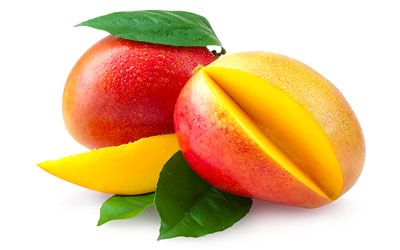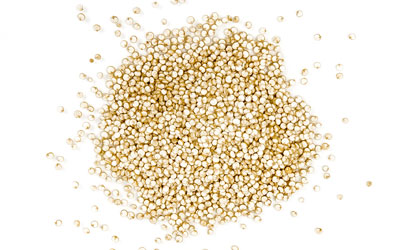In the early 1900's, the daughter of a cranberry farmer teamed up with a botanist after she found out he was searching for an ideal wild plant for breeding. This began the subsequent blueberry epidemic that has swept North America. Since then, studies have continued to uncover this fruit's health benefits on and off the table.
Blueberry Medicinal Properties
Health Benefits of Blueberry
Throughout the years, blueberries have been widely consumed for their nutritional benefits. Some of the many attributes that blueberries are praised for include being high in antioxidants, fiber, potassium, manganese, and vitamins C, A, B complex, and E. The combination of these vitamins and minerals within the fruit also allows blueberries to be used for an assortment of medicinal purposes, including:
Improving eye health. Blueberries can enhance ocular health, helping prevent glaucoma and cataracts. They have also been shown to be effective for treating corneal ulcers.
Preventing bacterial infections. Blueberries help inhibit the growth of bacteria along the lining of the urinary tract, thus preventing UTIs.
Stimulating bowel movements. The high amount of dietary fiber in blueberries gives them laxative properties that help regulate gastrointestinal functions.
Improving cognitive functions. Several studies have shown that supplementation with blueberries offers cognitive benefits in older adults.1
Promoting heart health. A clinical trial on women with hypertension has revealed that eating blueberries may reduce blood pressure.2
Several studies have also shown that blueberries may benefit adults with metabolic syndrome, thanks to their effects on reducing oxidative stress and inflammation.3 Additionally, it has been also found that regular consumption of blueberries may positively affect health parameters of diabetics.4 In fact, a study has found that eating blueberries and soluble fiber may lower gestational diabetes risk.5
Blueberries are also used as anti-aging remedies due to the high number of antioxidants present within these fruits.
How It Works
There are many compounds within blueberries that contribute to improving the body's overall health. Blueberries are one of the highest-ranked fruits for antioxidants due to the presence of a type of flavonoids called anthocyanins, which are also responsible for the fruit's dark blue color.
The high antioxidant content of blueberries contributes many health benefits, such as boosting the production of cytokines, which are small proteins that interact with other cells and help regulate immune responses, promote anti-inflammatory activity, and strengthen cell membranes, among other important functions.
Interestingly, a clinical trial has found that eating naturally flavonoid-rich wild blueberries may help treat depression among teenagers.6
Blueberries are great for treating and preventing urinary tract infections. Though their clinical effects on UTIs have not been fully investigated, their antioxidant compounds have been found to offer antibacterial actions, blocking the adhesion of Escherichia coli to the walls of the urinary tract. Moreover, pterostilbene, another antioxidant compound contained in blueberries, has been shown to be just as effective in lowering cholesterol as commercial drugs.
BLUEBERRIES ARE ONE OF THE HIGHEST-RANKED FRUITS FOR ANTIOXIDANTS.
Cleavers, myrtle, and neem also possess antibacterial properties, while acai, camu camu, carrot, and persimmon can be used as alternative sources for antioxidant benefits as well.
Blueberry Side Effects
It is safe to consume antioxidant-rich fruits such as blueberries in recommended amounts. With a balanced diet that includes five daily servings of fruits and vegetables, intoxication through food is more difficult to achieve than it is through supplements. However, consuming blueberries in excess can cause stress in the body and negatively affect its capacity to detoxify or repair itself.
OVERCONSUMPTION OF ANTIOXIDANTS SUPPRESSES BODY'S ABILITY TO FUNCTION PROPERLY.
Blueberry Cautions
Women who are pregnant or breastfeeding should only eat recommended amounts of any food high in antioxidants, such as blueberries.
Since blueberries may lower blood sugar levels, diabetics taking medications and those who need a consistent blood sugar level before certain medical procedures should reduce their consumption of these fruits. It is recommended for patients to stop consuming blueberry products at least two weeks before a scheduled surgery.
- Medicinal action Antibacterial, Antioxidant
- Key constituents Anthocyanins, antioxidants
- Ways to use Capsules, Hot infusions/tisanes, Liquid extracts, Food, Juiced, Ointment, Syrup, Essential oil, Dried
- Medicinal rating (4) Very useful plant
- Safety ranking Safe
Blueberry Nutrition
On the nutritional side, blueberries are a good source of vitamin K (phylloquinone), which is necessary for proper coagulation, as well as for improving bone health, thus reducing the risk of fractures. Manganese,on the other hand, is an essential mineral that helps in the breakdown of carbohydrates, the absorption of calcium, and the regulation of bloodsugar, whereas vitamin C (ascorbic acid) promotes immunity, stimulates the formation of collagen, and contributes to plant-based iron absorption.
Additionally, the copper in blueberries plays an important role in the production of red blood cells, as well as in the well-functioning of blood vessels, bones, nerves, and immune system.
Blueberries also contain very small amounts of many other nutrients,such as calcium, iron, magnesium, phosphorus, potassium, zinc, B-complex vitamins, choline, and vitamin E.
100 grams of blueberries provide 57 calories and 10% of the daily value for dietary fiber.
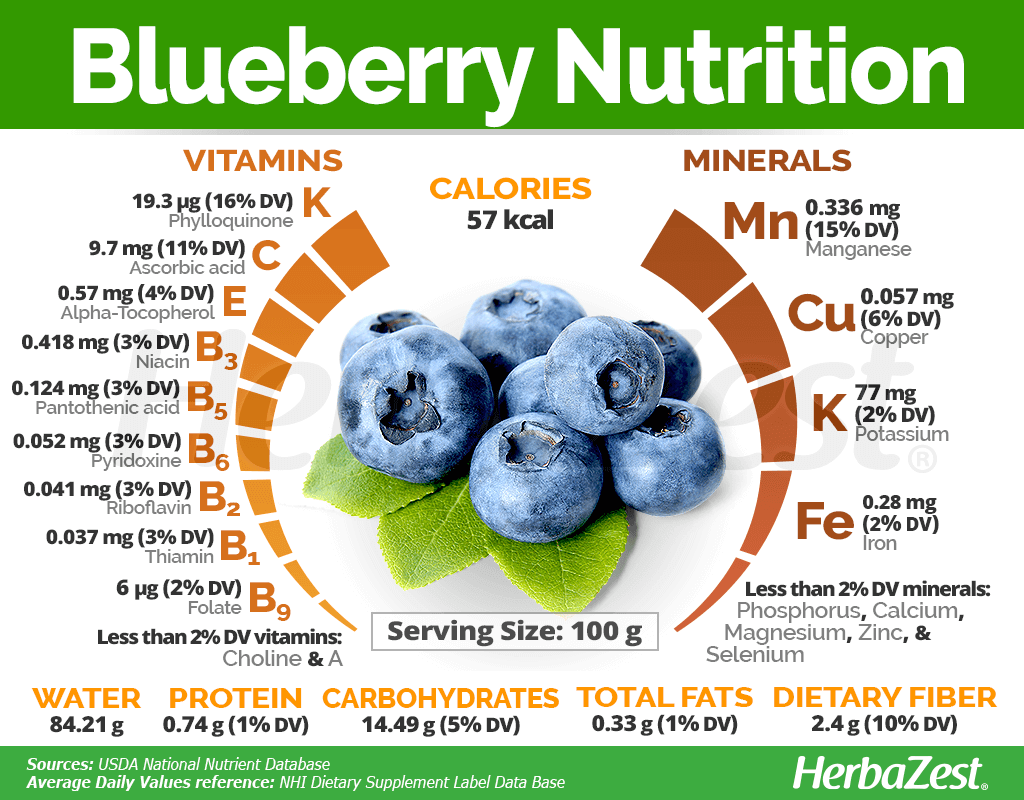
How to Consume Blueberry
The most effective way of obtaining the health benefits from blueberries is by eating them raw due to their high vitamin and mineral content. However, for medicinal purposes, the properties of blueberries can be taken in concentrated forms, in a variety of preparations.
Natural Forms
Raw. Eating them raw offers consumers high amounts of fiber, vitamins, and minerals.
Dried. Both dried blueberry fruit and dried blueberry leaves share astringent properties and are used to treat diarrhea.
Juice. Juice has been added to many cosmetic products to rejuvenate the skin thanks to the fruit's antioxidant benefits.
Infusion. Blueberry tea is often made from the leaves and is used to alleviate sore throats and swelling or inflammation of the mouth.
The antioxidant benefits of blueberries can also be obtained from the frozen berries, as well as from preserves, such as syrups, jams, and marmalades.
Herbal Remedies & Supplements
Liquid extract. An extract made from blueberry leaves is believed to aid in reducing blood sugar levels.
Oil.Blueberry seed oil carries the antioxidant action of the fresh blueberries, and it is considered a great soothing and anti-aging preparation for the skin.
Cream. Various forms of blueberries have been added to cosmetics, skin care ointments, and facial creams for anti-aging benefits.
Capsules. This supplemental form of blueberry comes in standardized doses. Blueberry pills are thought to lower blood pressure, fight against inflammation, and reduce cholesterol levels.
- Edible parts Fruit
- Edible uses Condiment, Beverage
- Taste Sweet, Tart
Growing
Growing blueberry shrubs requires very specific conditions. They grow best in acidic soils and with full sun, sometimes partial shade. However, full sun translates into more blooms and, consequently, more fruit.
Growing Guidelines
Blueberry shrubs are often found growing in or near swampy areas, as they require a lot of water.
In order to thrive, blueberries require cool weather. They are able to withstand temperatures of -5 to -13°F (-20 to -25°C ) without damage.
Blueberries grow best in acidic soil (pH levels of 4.0 - 5.0) that is loose, well-drained, and high in organic matter.
The best time to plant blueberries in North America is in late April or early May, and harvest falls from late July to mid-August.
For standard shrubs, space blueberries at least three feet (1 m) apart from each other, depending on the specific cultivar.
Blueberry plants grow slowly. It takes 8 - 10 years for them to reach mature size; however, they will begin to bear fruit after two to three years and better yields after five years.
Blueberries can be propagated in a variety of ways, but softwood or hardwood cuttings are the most common techniques. For home gardeners, a good option is to buy seedlings from a local nursery or garden center.
Some common insect pests of blueberries are spotted wing drosophila, Japanese beetles, leaf rollers, and forest tent caterpillars. Also, common diseases include canker, armillaria root rot, and ringspot viruses.
Detailed information about growing blueberries can be found in the herb garden section.
- Life cycle Annual
- Harvested parts Leaves, Fruit
- Light requirements Full sun, Partial shade
- Soil Well-drained
- Soil pH 3.5 – 4.4 (Extremely acidic), 4.5 – 5.0 (Very strongly acidic)
- Growing habitat Cool temperate regions, Humid regions
- USDA Plant Hardiness Zones 6a, 6b, 7a, 7b, 8a, 8b, 9a, 9b, 10a, 10b
- Planting time Early spring
- Plant spacing average 1 m (3.28 ft)
- Propagation techniques Cuttings
- Potential insect pests Caterpillars, Japanese beetles
- Potential diseases Root rot
- Potential animal pests Birds
Additional Information
Plant Biology
Blueberry is a deciduous shrubs native to the eastern United States, with branching that extends upright, and it can reach up 6 - 12 feet (1.8 - 3.7 m) tall with an equal width. Blueberry flowers are white to very light pink and bloom in clusters in May. The older stems of the shrub are colored gray-brown with newer ones a yellow-green to reddish color in the winter.
Classification
Blueberry (Vaccinium corymbosum) is a member of the Ericaceae or heath family, which comprises over 100 genera and more than 3,000 species worldwide. This large group is composed by woody shrubs with dark green leaves, bell shaped flowers and multi-seeded berries.
The genus Vaccinium is represented by over 400 species, including bilberry (Vaccinium myrtillus), Cranberry (Vaccinium oxycoccos), hucklberry (Vaccinium membranaceum), and lingonberry (Vaccinium vitis-idaea).
Cultivars of Blueberry
Many cultivars of blueberries have been selected based on their growth habits and fruit traits. Some of the more common cultivars in North America include the 'Bluecrop', 'Blueray', 'Jersey', 'North Blue', 'Sunshine Blue', 'Rubel', and 'Patriot'.
Historical Information
Before the blueberry boom happened, Native Americans used these dynamic berries for medicinal purposes and natural flavoring. It wasn't until the early 1900's when the American botanist Frederick Coville partnered with Elizabeth White, a recognized authority on native plants from New Jersey, to grow the first successful field of blueberries. In 1916, the blueberries began their journey to the table, when the highbush species was first sold.
Blueberries continue to be celebrated as a cultural phenomenon, with July named as National Blueberry Month by the USDA in 1974. The research on blueberries' antioxidants began in the 1990's and continues to this day.
Economic Data
The United States continues to be the world's largest producer of blueberries, in which 14 states produce the antioxidant-rich berries. In 2014, the United States produced and used 563.2 million pounds (255.5 million kg) of cultivated blueberries and exported 79 million pounds (36 million kg) of the fresh fruit to Canada, Japan, and other countries.
The United States is also a net importer of blueberries, a large majority of which comes from Chile during the winter, while Canada provides almost a fifth of the fresh blueberries coming into the U.S. as well.
Other Uses
Gardening. Blueberry shrubs are also used as ornamental plants for hedge borders and wind blocks.
Cosmetics. Due to blueberries' antioxidant characteristics, their use in personal care products has begun to increase. Blueberries can now be seen as an ingredient in face masks, scrubs, shampoos, and creams.
MRI tests. Health providers have also used this liquid for MRI imaging as an oral contrast agent due to its high manganese concentration.
Overall, blueberries provide consumers a myriad of vitamins and minerals that assist with bodily functions. They can be prepared and consumed in many ways, or even used for medicinal purposes. For anyone in the pursuit of healthier options, it may be wise to consider growing or purchasing blueberry products as a viable option toward living a healthier lifestyle.
- Other uses Cosmetics
Sources
- Agricultural Marketing Resource Center, Blueberries
- Disease Prevention and Treatment
- Genetic Diversity and Erosion in Plants: Case Histories, p.90
- Journal of Biomedicine and Biotechnology, Anthocyanins and Human Health: An In Vitro Investigative Approach, 2004
- National Institutes of Health, Blueberry
- New Jersey Historical Commission, Elizabeth White and the Blueberry Business
- North Carolina State University, Growing Blueberries in the Home Garden
- Oregon State University, Blueberries
- Penn State University, Home Lawn and Garden: Blueberries
- Reed College, Ericaceae
- The Egyptian Journal of Radiology and Nuclear Medicine, Effectiveness of natural oral contrast agents in magnetic resonance imaging of the bowel, 2015
- The Southern Region Small Fruit Consortium, Blueberry Propagation Suggestions
- U.S. Highbush Blueberry Council, Blueberry Season | Buying Blueberries | Health research | The Berry Latest
- University of Connecticut, Vaccinium corymbosum: Highbush Blueberry
- University of Michigan Health, Blueberry
- University of Minnesota, Extension - Yard and Garden: Blueberries for home landscapes | Extension: Pest management for home blueberry plants
- University of Wisconsin, The Highbush Blueberry
- Journal of Agricultural and Food Chemistry, Pterostilbene, a New Agonist for the Peroxisome Proliferator-Activated Receptor α-Isoform, Lowers Plasma Lipoproteins and Cholesterol in Hypercholesterolemic Hamsters, 2005
Footnotes:
- Royal Society of Chemistry. (2021). Blueberry phenolics are associated with cognitive enhancement in supplemented healthy older adults. Retrieved February 24, 2022 from https://pubs.rsc.org/en/content/articlelanding/2021/fo/d0fo02125c
- Journal of the Academy of Nutrition and Dietetics. (2015). Daily Blueberry Consumption Improves Blood Pressure and Arterial Stiffness in Postmenopausal Women with Pre- and Stage 1-Hypertension: A Randomized, Double-Blind, Placebo-Controlled Clinical Trial. Retrieved February 24, 2022 from https://pubmed.ncbi.nlm.nih.gov/25578927/
- Food & Function. (2017). Blueberry supplementation attenuates oxidative stress within monocytes and modulates immune cell levels in adults with metabolic syndrome: a randomized, double-blind, placebo-controlled trial. Retrieved February 24, 2022 from https://pubs.rsc.org/ko/content/articlelanding/2017/fo/c7fo00815e/unauth#!divAbstract
- Current Developments in Nutrition. (2020). Effect of Blueberry Consumption on Cardiometabolic Health Parameters in Men with Type 2 Diabetes: An 8-Week, Double-Blind, Randomized, Placebo-Controlled Trial. Retrieved February 24, 2022 from https://academic.oup.com/cdn/article/4/4/nzaa030/5800977?login=true
- The Journal of Nutrition. (2021). Dietary Blueberry and Soluble Fiber Supplementation Reduces Risk of Gestational Diabetes in Women with Obesity in a Randomized Controlled Trial. Retrieved August 6, 2024, from https://pubmed.ncbi.nlm.nih.gov/33693835/British
- Journal of Nutrition. (2020). Effect of 4 weeks daily wild blueberry supplementation on symptoms of depression in adolescents. Retrieved February 24, 2022 from https://www.cambridge.org/core/journals/british-journal-of-nutrition/article/effect-of-4-weeks-daily-wild-blueberry-supplementation-on-symptoms-of-depression-in-adolescents/E8ED12AC48E936A4A8D6664B93AD6AA6
